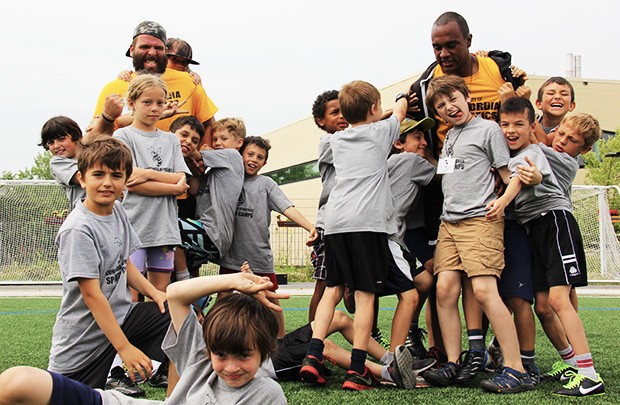Erin O’Loughlin is a certified personal trainer, pre-post natal and Barre fitness instructor. She is also a research coordinator at the CRCHUM working on the project AdoQuest, whose main objective is to determine the extent of co-occurrence of modifiable lifestyle behaviors among youth along the life course.
Blog post
What Can We, as Parents, Do to Encourage Our Children to Be Physically Active?
 Family activity time
Family activity time
It would be helpful if our children did all the physical activity they needed to be healthy at school, but this is not the case. Although research indicates that physical activity during the school day has academic as well as mental and physical health benefits, much of the time allotted for children to be active during school has been cut back or even eliminated. In fact, fewer than 8% of children are active enough to obtain the health benefits of physical activity. Therefore, on top of our other parent responsibilities, we must also work hard to assure that our children are as active as they should be. This can be a great way for families to interact as families, and it can also be good fun.
So, what does the research tell us about what we can do as parents, to assure that our children are active and remain active?
1. First, it is important to know what the current guidelines for physical activity and sedentary behavior are for your child’s age group, and to assess if your child is active enough. Participaction is a great online resource that provides these guidelines according to age. In addition, it offers lots of practical advice and guidance. Begin by identifying how much activity is recommended for your child’s age group. Then, track your child’s activity for a week or two. Also track their sedentary behaviour, screen time and sleep and compare these to the guidelines. This exercise can be a real eye-opener. You need to know where you are at, in order to set goals for the future. Finding a healthy balance of physical activity, sedentary time and sleep is very important at an early age, and it helps establish healthy lifestyle habits for life.
2. Second, remember that intentionally or unintentionally, you are a role model for your child. The Number One predictor of a child’s level of physical activity is the parents’ level of physical activity. This doesn’t mean that you have to begin to play on a competitive sports team or join the gym. But find an activity that you like and can sustain, and show your child how much you like it and how good it makes you feel. Better yet, be active with your child! Go outside, play, join a family activity class or play active video games together. Although 79% of parents support their children’s physical activity financially, only 36% of parents with children ages 5- 17 report playing active games with their children. We can do better! It doesn’t have to be a 2-hour event - prioritizing a walk after dinner, or doing some push-ups and sit-ups together for 5 minutes in front of the TV is great!
3. Third, active transportation. Only 25% of Canadian parents say their children ages 5-17 typically walk or bike to and from school; 58% report that their children are driven. Of children ages 11-15, 24% walk to school and 2% bike. If possible, make it a priority to walk or bike to and from school with your child, or encourage them to do this on their own! This is a great way to help children become and remain more active!
4. Fourth, let your child participate in all the activities that they express an interest in. Don’t force your child into an activity. However, if they begin an activity, don’t let them stop if “they don’t like it”. It would be great if your child wants to and enjoys the specific sport you want them to, but this shouldn’t be forced. Remember role modelling! In order to foster a long-term love of physical activity, a child must develop good memories of the activity, which may not happen if they are forced into something they never wanted to try. BUT, if they want to play soccer, they must commit for at least the season. There will be times when they are discouraged or don’t want to practice, but it was their choice to play and they must stick it out. They will thank you in the end for encouraging them, despite occasional reluctance.
5. Fifth, let your child try a lot of different activities, rather than have them specialize in one. There are exceptions to this (i.e., if your child truly excels and only loves one activity). But in general, research shows that adults who are physically active were children who tried many sports and activities in their early years, and were not pressured to play high calibre or specialized sports in youth.
6. Finally, reducing screen or sedentary time in general will help children be more active. You don’t have to force them to be active as a replacement, but turning off the screens will encourage them to find other activities that may get them moving.
You cannot expect a child to simply love physical activity.
A love for activity cannot be taken for granted. Being active may have to be fostered and encouraged (it may not), but encouragement is extremely important. Let your children know why exercise is important and why it is so great. The goal is not to badger them that they HAVE to do it, but to explain why they should WANT to do it, and SHOW them how to do it.
About the author


